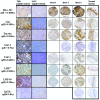Down-regulation of Human Leukocyte Antigen class I heavy chain in tumors is associated with a poor prognosis in advanced esophageal cancer patients
- PMID: 22134332
- PMCID: PMC3584652
- DOI: 10.3892/ijo.2011.1274
Down-regulation of Human Leukocyte Antigen class I heavy chain in tumors is associated with a poor prognosis in advanced esophageal cancer patients
Abstract
The HLA class I antigen processing machinery (APM) plays a crucial role in the anticancer immune response. The aim of this study was to assess the clinical significance of APM components in esophageal cancer. A total of 11 esophageal cancer cell lines were evaluated by Western blot analysis for 13 HLA class I APM components. There was a different expression pattern among cancer cell lines for HLA class I heavy chain (HLA-HC), β2 microglobulin, Tapasin, TAP-1, TAP-2, LMP-7 and LMP-10. Immunohistochemical staining utilizing a tissue microarray method for HLA class I APM expression showing different expression patterns among cell lines was performed for 95 surgical specimens from patients with esophageal cancer. Prognostic factors were the down-regulation of HLA-HC, and the up-regulation of β2 microglobulin and TAP-1 in the cancer tissues. Multivariate analysis using a Cox regression model indicated that the down-regulation of HLA-HC, and up-regulation of TAP-1 in cancer tissues are independent, unfavorable prognostic factors (hazard ratio, 2.361 and 2.297; P=0.0141 and 0.0145, respectively). Although there was no significant difference in survival for selected p-stage I and II patients (n=54) in all APM components, only down-regulation of HLA-HC was an unfavorable prognostic factor by a Cox regression model for selected p-stage III and IV patients (n=41). In conclusion, the current results suggest that the down-regulation of HLA-HC in tumors is especially associated with a poor prognosis among advanced esophageal cancer patients.
Figures




Similar articles
-
Correlation of HLA-A02* genotype and HLA class I antigen down-regulation with the prognosis of epithelial ovarian cancer.Cancer Immunol Immunother. 2012 Aug;61(8):1243-53. doi: 10.1007/s00262-012-1201-0. Epub 2012 Jan 19. Cancer Immunol Immunother. 2012. PMID: 22258792 Free PMC article.
-
HLA class I is most tightly linked to levels of tapasin compared with other antigen-processing proteins in glioblastoma.Br J Cancer. 2015 Sep 15;113(6):952-62. doi: 10.1038/bjc.2015.297. Epub 2015 Aug 27. Br J Cancer. 2015. PMID: 26313662 Free PMC article.
-
Association of defective HLA-I expression with antigen processing machinery and their association with clinicopathological characteristics in Kazak patients with esophageal cancer.Chin Med J (Engl). 2011 Feb;124(3):341-6. Chin Med J (Engl). 2011. PMID: 21362330
-
Evolution of studies of HLA class I antigen processing machinery (APM) components in malignant cells.Clin Transpl. 2013:453-63. Clin Transpl. 2013. PMID: 25095541 Review.
-
Human Leukocyte Antigen Class I Antigen-Processing Machinery Upregulation by Anticancer Therapies in the Era of Checkpoint Inhibitors: A Review.JAMA Oncol. 2022 Mar 1;8(3):462-473. doi: 10.1001/jamaoncol.2021.5970. JAMA Oncol. 2022. PMID: 34940799 Free PMC article. Review.
Cited by
-
The key role of calreticulin in immunomodulation induced by chemotherapeutic agents.Int J Clin Oncol. 2015 Apr;20(2):386-94. doi: 10.1007/s10147-014-0719-x. Epub 2014 Jun 28. Int J Clin Oncol. 2015. PMID: 24972573
-
Targeting EGFR-binding protein SLC7A11 enhancing antitumor immunity of T cells via inducing MHC-I antigen presentation in nasopharyngeal carcinoma.Cell Death Dis. 2025 Jan 16;16(1):21. doi: 10.1038/s41419-024-07327-9. Cell Death Dis. 2025. PMID: 39820491 Free PMC article.
-
Differential prognostic impact of CD8+ T cells based on human leucocyte antigen I and PD-L1 expression in microsatellite-unstable gastric cancer.Br J Cancer. 2020 Apr;122(9):1399-1408. doi: 10.1038/s41416-020-0793-y. Epub 2020 Mar 17. Br J Cancer. 2020. PMID: 32203213 Free PMC article.
-
Reduced Expression of the Antigen Processing Machinery Components TAP2, LMP2, and LMP7 in Tonsillar and Base of Tongue Cancer and Implications for Clinical Outcome.Transl Oncol. 2015 Feb;8(1):10-7. doi: 10.1016/j.tranon.2014.11.002. Transl Oncol. 2015. PMID: 25749172 Free PMC article.
-
Bioinformatic-Experimental Screening Uncovers Multiple Targets for Increase of MHC-I Expression through Activating the Interferon Response in Breast Cancer.Int J Mol Sci. 2024 Sep 30;25(19):10546. doi: 10.3390/ijms251910546. Int J Mol Sci. 2024. PMID: 39408874 Free PMC article.
References
-
- Ando N, Iizuka T, Ide H, Ishida K, Shinoda M, Nishimaki T, Takiyama W, Watanabe H, Isono K, Aoyama N, Makuuchi H, Tanaka O, Yamana H, Ikeuchi S, Kabuto T, Nagai K, Shimada Y, Kinjo Y, Fukuda H. Surgery plus chemotherapy compared with surgery alone for localized squamous cell carcinoma of the thoracic esophagus: a Japan Clinical Oncology Group Study - JCOG9204. J Clin Oncol. 2003;21:4592–4596. - PubMed
-
- Adham M, Baulieux J, Mornex F, de La Roche de Bransat E, Ducerf C, Souquet JC, Gerard JP. Combined chemotherapy and radiotherapy followed by surgery in the treatment of patients with squamous cell carcinoma of the esophagus. Cancer. 2000;89:946–954. - PubMed
-
- Morita M, Yoshida R, Ikeda K, Egashira A, Oki E, Sadanaga N, Kakeji Y, Yamanaka T, Maehara Y. Advances in esophageal cancer surgery in Japan: an analysis of 1000 consecutive patients treated at a single institute. Surgery. 2008;143:499–508. - PubMed
-
- Cho Y, Miyamoto M, Kato K, Fukunaga A, Shichinohe T, Kawarada Y, Hida Y, Oshikiri T, Kurokawa T, Suzuoki M, Nakakubo Y, Hiraoka K, Murakami S, Shinohara T, Itoh T, Okushiba S, Kondo S, Katoh H. CD4+ and CD8+ T cells cooperate to improve prognosis of patients with esophageal squamous cell carcinoma. Cancer Res. 2003;63:1555–1559. - PubMed
MeSH terms
Substances
LinkOut - more resources
Full Text Sources
Medical
Research Materials
Miscellaneous

